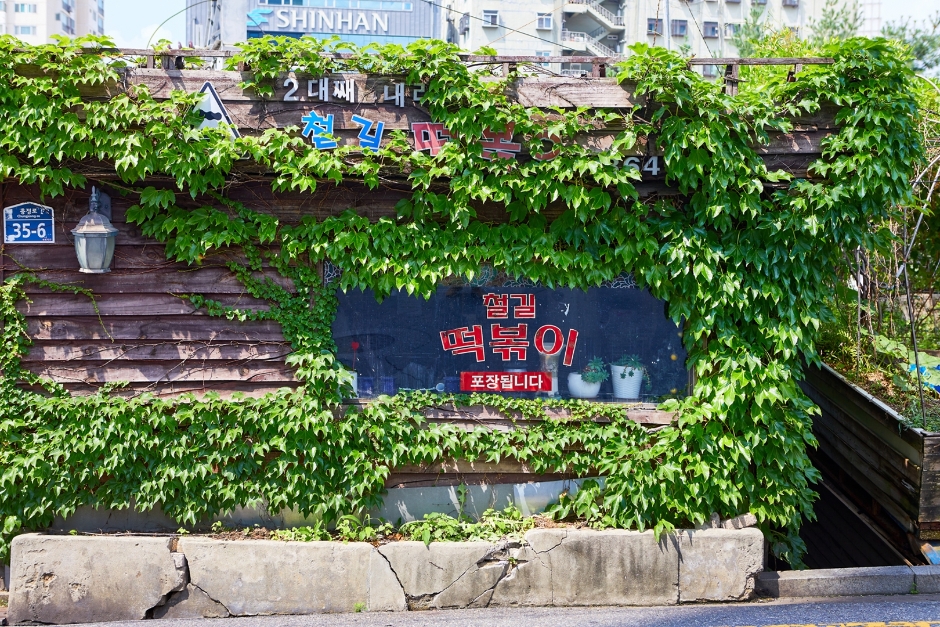Jeonju Kongnamul Hanu Gukbap (전주콩나물한우국밥)
10.4Km 2021-03-19
33, Simgok-ro, 9beon-gil, Bucheon-si, Gyeonggi-do
+82-32-613-3131
Experience Jeonju-style bean sprout rice soup. The representative menu is bean sprout and rice soup. This is a Korean cuisine located in Bucheon-si, Gyeonggi-do.
Cheolgil Tteokbokki (철길떡볶이)
10.4Km 2024-03-18
35-6 Chungjeong-ro, Seodaemun-gu, Seoul
Cheolgil Tteokbokki is a famous pilgrimage site for tteokbokki lovers. As the name suggests, it is located next to the railroad (“cheolgil” in Korean) near Chungjeongno Station. There is a wide variety of Korean dishes available, from tteokbokki that will bring back childhood memories to gimbap, deep-fried dishes, and sundae. As the name suggests, it is located next to the railroad near Chungjeongno Station. The restaurant has been in operation for two generations while maintaining its original appearance. The old signboard and exterior have a nostalgic feeling. Unlike tteokbokki in soup, which is currently popular, this tteokbokki with chewy rice cakes is coated well with thick spicy sauce. It's very delicious when mixed with the restaurant’s deep-fried foods. Visitors are recommended to take the seat outdoors to enjoy the view of the railroad tracks while eating.
Yongsan ETLand (용산전자랜드)
10.4Km 2021-06-09
74, Cheongpa-ro, Yongsan-gu, Seoul
+82-2-707-4700
Yongsan ETLand is an enormous wholesale electronics market located near the Yongsan Train Station, where all needs relating to computers, imported audio systems, game utilities and more are aptly answered. This mall first opened in 1988 as a part of the city's redevelopment project, and became the leading electronics distributer in Korea. The mall is considered the go-to place for anyone interested in purchasing electronics, whether it'd be computers, cameras, digital gadgets, electronic parts, or other IT products.
Hyeopjin Computer [Tax Refund Shop] (협진컴퓨터)
10.4Km 2024-04-23
3F, 74, Cheongpa-ro, Yongsan-gu, Seoul
-
Audio Park - Yongsan ETLand Branch [Tax Refund Shop] (오디오파크 용산전자랜드)
10.4Km 2024-04-22
74, Cheongpa-ro, Yongsan-gu, Seoul
-
Choi Com - Yongsan ETLand Branch [Tax Refund Shop] (초이컴 용산전자랜드)
10.4Km 2024-04-18
Store #A-335, 3F, ET LAND (Main Bldg.), 74, Cheongpa-ro, Yongsan-gu, Seoul
-



![HB Coms [Tax Refund Shop] (에이치비컴즈)](http://tong.visitkorea.or.kr/cms/resource/94/2891194_image2_1.jpg)
![Sjkcnc [Tax Refund Shop] (에스제이케이씨엔씨)](http://tong.visitkorea.or.kr/cms/resource/96/2891196_image2_1.jpg)
![Hyeopjin Computer [Tax Refund Shop] (협진컴퓨터)](http://tong.visitkorea.or.kr/cms/resource/04/2891204_image2_1.jpg)
![Old and New [Tax Refund Shop] (올드앤뉴)](http://tong.visitkorea.or.kr/cms/resource/10/2891210_image2_1.jpg)
![Banwol Audio [Tax Refund Shop] (반월음향)](http://tong.visitkorea.or.kr/cms/resource/18/2891218_image2_1.jpg)
![Audio Park - Yongsan ETLand Branch [Tax Refund Shop] (오디오파크 용산전자랜드)](http://tong.visitkorea.or.kr/cms/resource/92/2878492_image2_1.jpg)
![Choi Com - Yongsan ETLand Branch [Tax Refund Shop] (초이컴 용산전자랜드)](http://tong.visitkorea.or.kr/cms/resource/00/2878500_image2_1.jpg)
 English
English
 한국어
한국어 日本語
日本語 中文(简体)
中文(简体) Deutsch
Deutsch Français
Français Español
Español Русский
Русский